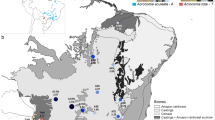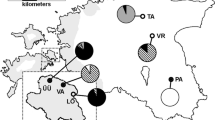Abstract
Cycas taitungensis Shen, Hill, Tsou & Chen is an endemic species remaining in two remnant populations in southeastern Taiwan. Ecological studies showed that the sex ratio between female and male of the main population is approximately 1.7:1. Leaf production was found to be correlated with tree height before reaching 1 m in length (r = 0.95). The annual reproduction rate of female plants is highly variable, with seed numbering between 80 and 400 in each tree. The site study revealed a significant difference in vegetative growth and age structure between the subpopulations collected in two opposite microhabitats. Genetic studies using isozyme analysis showed low genetic variability (HE = 0.039) and little genetic differentiation between the populations (FST = 0.051). The genetic data are well correlated with the ecological observation that the differences reflect various microhabitat effects within a very local environment and that the impact influenced the extent of the degree of genetic differentiation within local populations. This work presents extensive genetic information forC. taitungensis that give rise to more ecological and genetic insights into the plant for better establishment of in situ and ex situ conservation programs.
Similar content being viewed by others
Literature Cited
Byrne, M. &H. James. 1991. Genetic diversity in the cycadMacrozamia riedlei. Heredity 67: 35–39.
Chiang, Y. C., S. Huang, C. H. Chou &T. Y. Chiang. 1999. Organelle DNA phylogeography ofCycas taitungensis, a relic species in Taiwan. P. 341in Abstracts: XVI International Botanical Congress, St. Louis, USA, August 1–7.
Conkle, M. T., P. D. Hodgskiss, L. B. Nunnally &S. C. Hunter. 1982. Starch gel electrophoresis of conifer seeds: A laboratory manual. U.S. Department of Agriculture, Forest Service, Pacific South-west Forest and Range Experiment Station, Berkeley, CA.
De Laubenfels, D. &F. Adema. 1998. Ataxonomic revision of the generaCycad andEpicycas gen. Nov. (Cycadaceae). Blumea 43: 351–400.
Ellstrand, N., R. Ornduff &J. M. Clegg. 1990. Genetic structure of the Australian cycad,Macrozamia communis (Zamiaceae). Amer. J. Bot. 77: 677–681.
Given, D. R. 1994. Principles and practice of plant conservation. Chapman & Hall, New York
Hamrick, J. L. &M. J. W. Godt. 1989. Allozyme diversity in plant species. Pp. 46–55in A. D. H. Brown, M. T. Clegg, A. L. Kahler & B. S. Wies (eds.), Plant population genetics, breeding, and genetic resources. Sinauer Associates, Sunderland, MA.
—,H. M. Blanton &K. J. Hamrick. 1989. Genetic structure of geographically marginal populations of ponderosa pine. Amer. J. Bot. 76: 1559–1568.
Jones, D. 1993. Cycads of the world. Smithsonian Institution Press, Washington, DC.
Lin, T. P., Y. C. Sun, H. C. Lo & Y. P. Cheng. In press. Low genetic diversity ofCycas taitungensis (Cycacaceae), an endemic species in Taiwan, revealed by allozyme analysis. Taiwan J. For. Sci.
Loveless, M. D. &J. L. Hamrick. 1984. Ecological determinants of genetic structure in plant populations. Ann. Rev. Ecol. Syst. 15: 65–95.
Mitton, J. B., Y. B. Linhart, K. B. Sturgeon &J. L. Hamrick. 1979. Allozyme polymorphisms detected in mature needle tissue of ponderosa pine Mendelian nature of six protein polymorphisms. J. Hered. 70: 86–89.
Murphy, R. W., J. W. Sites Jr.,D. G. Buth &C. H. Haufler. 1996. Proteins: Isozyme electrophoresis. Pp. 121–132in D. M. Hillis, C. Moritz & B. K. Mable (eds.), Molecular systematics. Sinauer Associates, Sunderland, MA.
Nei, M. 1973. Analysis of gene diversity in subdivided populations. Proc. Natl. Acad. Sci. USA 70: 3312–3323.
— 1977. F-statistics and analysis of gene diversity in subdivided populations. Ann. Human Genetics 47: 225–233.
— 1978. Estimation of average heterozygosity and genetic distance from a small number of individuals. Genetics 89: 583–590.
— &R. K. Chesser. 1983. Estimation of fixation indexes and gene diversities. Ann. Human Genetics 47: 253–259.
—,P. A. Fuerst &R. Chakraborty. 1978. Subunit molecular weight and genetic variability of proteins in natural [Drosophila] populations. Proc. Natl. Acad. Sci. USA 75: 3359–3363.
Niklas, K. J. &K. Norstog. 1984. Aerodynamics and pollen grain depositional patterns on cycad megastrobili: Implications on the reproduction of three cycad genera (Cycas, Dioon, andZamia). Bot. Gaz. 145: 92–104.
Norstog, K. J. &T. J. Nicholls. 1997. The biology of the cycads. Cornell Univ., Ithaca, NY.
Ornduff, R. 1991. Size classes, reproductive behavior, and insect associates ofCycas media (Cycadaceae) in Australia. Bot. Gaz. 152: 203–207.
— 1992. Features of coning and foliar phenology, size classes, and insect associations ofCycas armstrongii (Cycadeae) in the Northern Territory, Australia. Bull. Torrey Bot. Club 119: 39–43.
Shen, C. F., K. D. Hill, C. H. Tsou &C. J. Chen. 1994.Cycas taitungensis C. F. Shen, K. D. Hill, C. H. Tsou & C. J. Chen,sp. nov. (Cycadaceae), a new name for the widely known cycad species endemic in Taiwan. Bot. Bull. Acad. Sin. 35: 133–140.
Soltis, D. E., C. H. Haufler, D. C. Darrow &G. J. Gastony. 1983. Starch gel electrophoresis of ferns: A compilation of grinding buffers, gel and electrode buffers, and staining schedules. Amer. Fern J. 73: 9–27.
Sun Y. C. 1998. The population genetic structure of Cycastaitungensis. Master’s thesis, National Taiwan Univ..
Swofford, D. L. &R. B. Selander. 1997. BIOSYS-2. University of Illinois, Urbana-Champaign.
Tang, W. 1987. Insect pollination in the cycadZamia pumila (Zamiaceae). Amer. J. Bot. 74: 90–99.
Vorster, P. 1995. Comments onCycas revoluta. Encephalartos 32: 1–11.
Walters, T. W. &D. S. Decker-Walters. 1991. Patterns of allozyme diversity in the West Indies cycadZamia pumila (Zamiaceae). Amer. J. Bot. 78: 438–445.
Wendel, J. F. &N. F. Weeden. 1989. Visualization and interpretation of plant isozymes. Pp. 233–245in D. E. Soltis & P. S. Soltis (eds.), Isozymes in plant biology. Dioscorides Press, Portland, OR.
Wright, S. 1943a. Isolation by distance. Genetics 28: 114–138.
— 1943b. Analysis of local variability of flower color inLinanthus parryae. Genetics 28: 139–156.
— 1965. The interpretation of population structure by F-statistics with special regard to systems of mating. Evolution 19: 395–420.
— 1978. Evolution and the genetics of populations. Vol. 4, Variability within and among natural populations. Univ. of Chicago Press, Chicago.
Yang, S. L. &A. W. Meerow. 1996. TheCycas pectinata (Cycadaceae) complex: Genetic structure and gene flow. Int. J. Pl. Sci. 157: 468–483.
Author information
Authors and Affiliations
Rights and permissions
About this article
Cite this article
Huang, S., Hsieh, HT., Fang, K. et al. Patterns of genetic variation and demography ofCycas taitungensis in Taiwan. Bot. Rev 70, 86–92 (2004). https://doi.org/10.1663/0006-8101(2004)070[0086:POGVAD]2.0.CO;2
Issue Date:
DOI: https://doi.org/10.1663/0006-8101(2004)070[0086:POGVAD]2.0.CO;2




